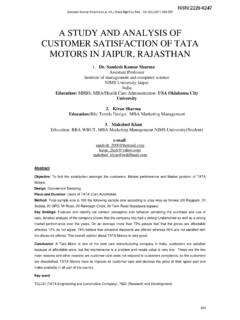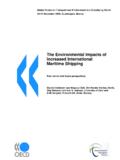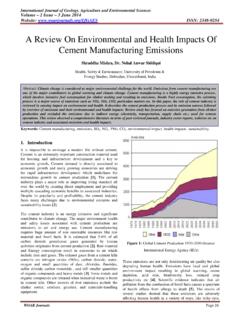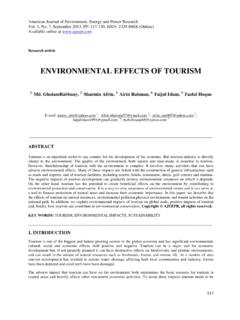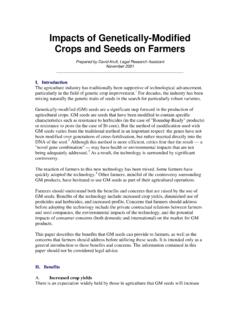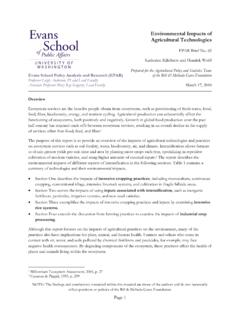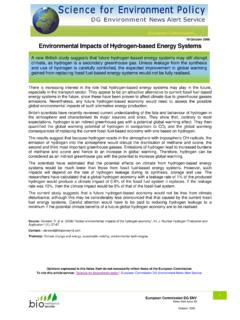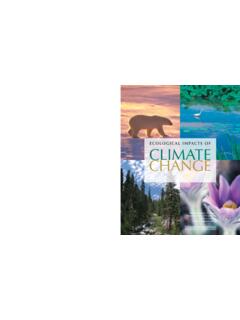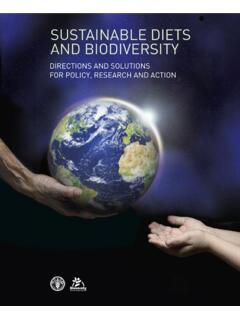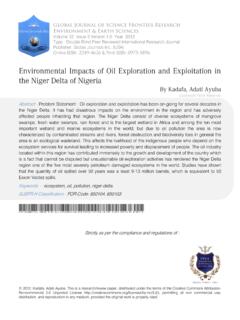Transcription of The Impacts of Economic Growth on Environmental …
1 The Impacts of Economic Growth on Environmental Conditions in Laos Hatthachan Phimphanthavong Local Development and Global Dynamics, Graduate School of Social Science, University of Trento, Italy Abstract This study aims to examine the relationship between Economic Growth and Environmental degradation. The carbon dioxide emission (CO emissions) per capita is used to be a proxy for Environmental degradation, using time series data from the period between 1980 and 2010. To avoid the problems of non-stationary associated with time series analysis, the Dickey-Fuller unit roots is checked as to ascertain whether the variables are stationary, by transforming the dependent and independent variables in the first different operator form. This study is based on the hypothesis of the Environmental Kuznets Curve (EKC) that Environmental degradation follows an inverted U-shaped trajectory in relation to Economic Growth . The result of this study confirms the invested correlation between Economic Growth and Environmental degradation of EKC s hypothesis that at the early stage Economic Growth increases Environmental degradation, then Environmental degradation decreases after reaching a certain level of average income per capita.
2 Moreover, other factors, such as trade openness, industrial extension, and becoming a full member of ASEAN, also cause an increase in Environmental degradation. In order to reach the sustainable development goal, strong Environmental and natural resource protection policies are suggested for the current and future development of Laos. Keywords: GDP per capita, trade openness, Environmental degradation and sustainability. I. INTRODUCTION The impact of sustained Growth on the environment has been widely discussed in the Economic literature. Several studies have investigated the relationship between Environmental pollution and per capita income, mostly by using the framework of Kuznets curve, which was introduced by Kuznets (1955), known as the inverted-U-shaped curve. This hypothesis, which suggests a U-shaped relationship between two variables, implies a non-linear relationship that is applicable in many countries.
3 The key indicators used to capture the changes in Environmental conditions have been developed and used in many countries. A high rate of Economic Growth has been a primary and permanent goal of government and society, particularly in developing countries. The increase in Economic Growth is related to an increase in the production and consumption of goods and services; consequently, this may lead to an increase in the multiplied goods of the people and income per capita consumption. Technological development has been considered as having the potential to diminish or exacerbate the effects of Economic Growth ; however, this depends on the net result regarding increased or decreased per capita natural resource consumption. To encourage a high rate of Growth , different economies mechanisms have involved development based on each individual country s characteristics and the potential natural resources that are available.
4 The Growth may produce negative Impacts on the environment through many aspects, such as Environmental condition (pollution), overexploitation of natural resources, degradation and loss of wildlife habitat, and climate change. These are the key issues that many countries have been facing; in particular, the decline in Environmental quality is considered to be a serious issue for the living condition of the population from the current as well as the long-term perspective. To achieve extreme development, the Economic condition should not be measured by the GDP Growth alone. Instead, the sustainability of natural resources and Environmental condition must be considered to be one key factor that can be used to prove that the benefit of Growth is distributed throughout the population and environment. Consequently, the strength of the country s economy must be incorporated into the condition to achieve Economic Growth .
5 On the other hand, if the national development goal is focused only on income Growth and fails to consider its Impacts on the natural resources and Environmental condition, this would confirm that the envisaged development guidelines and processes are inadequate for the long-term development perspective of the country. For this reason, to achieve successfully the goals of the various Economic development plans, a country s government needs to consider both the development potential to increase the living condition of the population and the sustainability that would ensure lasting benefits for the country s future generations. This paper highlights the situation of Laos, and aims to investigate the relationship between Economic Growth and the pressure on nature from the Environmental sustainability perspective. Considering at the Environmental condition, it seems that there are many aspects are included in Environmental condition, such as water pollution, Carbone Dioxide emissions (CO emissions), soil erosion, solid waste, and deforestation.
6 However, since we have Hatthachan Phimphanthavong | , Vol 4(5),2013, | ISSN: 2229-6247766 limited time and data available of other aspects, this study is considered only the CO emissions per capita to be a proxy for Environmental degradation. By definition, the increase of the CO emissions mainly causes from burning oil, coal, and natural gas for energy use. Furthermore, CO emissions also enters the atmosphere from burning wood and waste material land from some industrial process such as cement production, garment manufacturing, alcohol factories, Tabaco companies, etc. The increase in number of Economic activities is assumed to increase the proportion of Environmental damage this study would discuss some hints about how to accomplish the balance of the Growth and maintain a good condition of environment. As already mentioned in relation to the Environmental issue of Laos, which is only a minor contributor to climate change at global and regional levels, the degradation in the Environmental system, particularly the rapid decline of natural resources caused by factors such as deforestation, may cause a negative impact on the living condition of the population from the current and the long-term perspective.
7 This is due to the high rate of Growth in recent years relying on natural resources to support the export volume and also to increase the domestic productivity. In general, the Economic reform in Laos is successful in terms of boosting Growth ; however, it is greatly dependent on natural resources. The high rate of Growth is a promising prospect for the country to disembark from the list of LDCs and it is questionable whether the high rate of sustained Growth during the last two decades has produced negative Impacts on the natural resources and Environmental condition of the country. The expected outcome of this study may provide a good suggestion for policy makers to consider the most appropriate method to achieve a high level of Growth and simultaneously to maintain the sustainability of the natural system and a good Environmental condition. This paper consists of five sections including the introductory section. The next section contains a literature review.
8 In section 3, the methodology and data use is discussed, including the econometric models. The empirical results are detailed in section 4. The last section summarizes the outcome and makes some recommendations for future development. II. LITERATURE REVIEW Referring to the neoclassical Economic theory, sustainability can be identified in terms of the maximization of well-being of a population over time, while the economy is considered to be a major source of the improvement in the living condition of a country and its population (Lawrence, 2011). From this poin t of view, the progress of Growth occurs through the growing gconsumption of the country of both goods and services; therefore, the governments of many countries have emphasized the achievement of a high rate of Growth . The measurement of the Growth of sustainable development ( GDP Growth ) has been considered as a major objective of development. The Growth theory has relied on the hypothesis of Economic efficiency and dynamics optimality.
9 Grossman and Krueger (1991) state that the impact of Economic Growth on Environmental quality is categorized through three different channels: (1) the scale effect, (2) the composition effect, and (3) the technique effect. By definition, the scale effect happens as pollution increases with the size of the economy, the explanation being that even if the structure of the economy and technology does not change, it is assumed that an increase in the scale of Economic activity leads to an increase in pollution and Environmental degradation, while the composition effect refers to the change in production structure of an economy from agriculture-based to industry and service. In the first stage of the development process, pollution increases as the Economic structure changes from agriculture to resource-intensive heavy industries. The last effect is the technique effect, which captures improvements in the technique of production and adaption of cleaner technologies and hence a reduction in pollution.
10 Several studies have considered the impact of Growth on Environmental conditions. One of the most effective studies is that of Smyth and his colleagues (2008), who conducted an analysis of the relationship between Growth and Environmental issues in China, finding that together with the high rate of Economic Growth , it also produces a high rate of pollution. Many cities in China are now suffering from a high level of pollution and natural disasters, as well as a traffic congestion problem. Those problems are becoming a major challenge for the future development of China. Some studies have confirmed that the pursuit of higher Growth dominates the Environmental aspects. However, Environmental and social harm can limit long-run Growth ; therefore, the key factors of social, Economic and Environmental systems are codetermined. Thus, in order to obtain the objective of sustainable development, an expansion of the scope of analysis is required to encompass wider system dynamics (Munasinghe, 2001).
